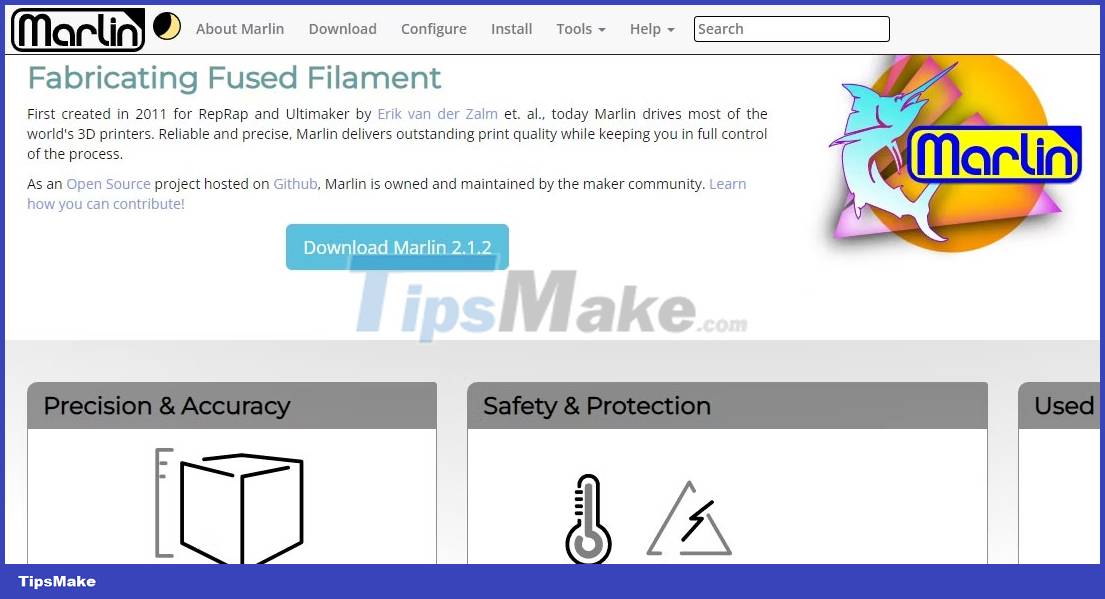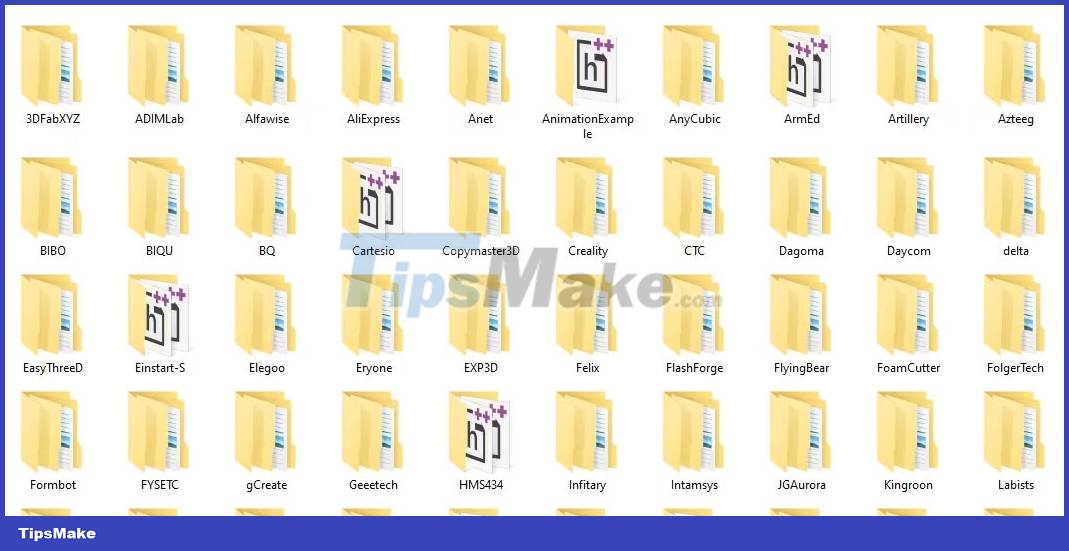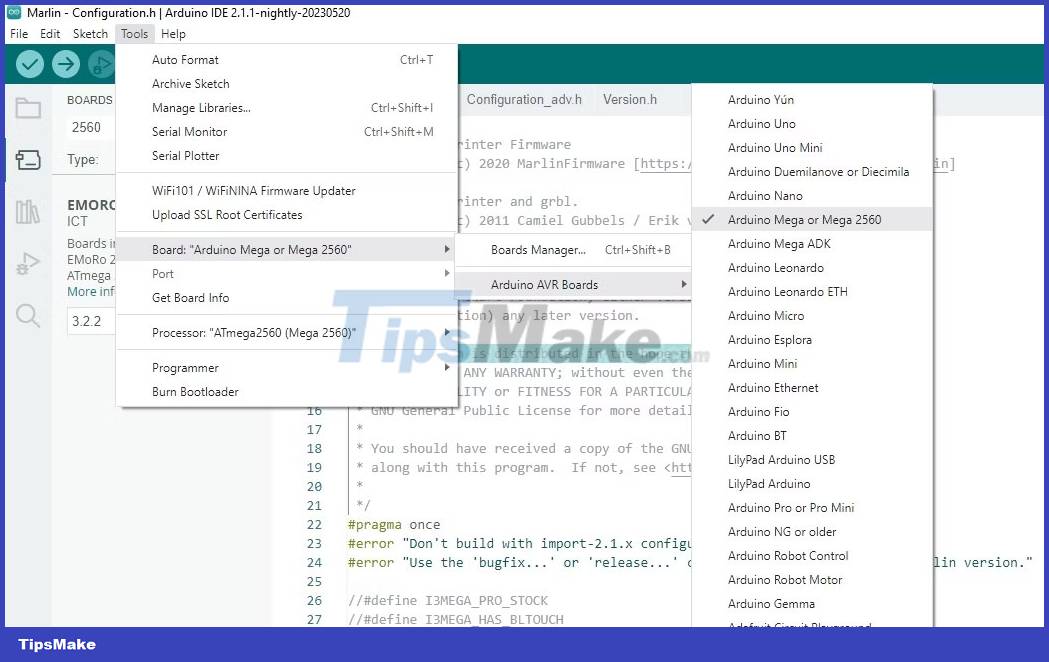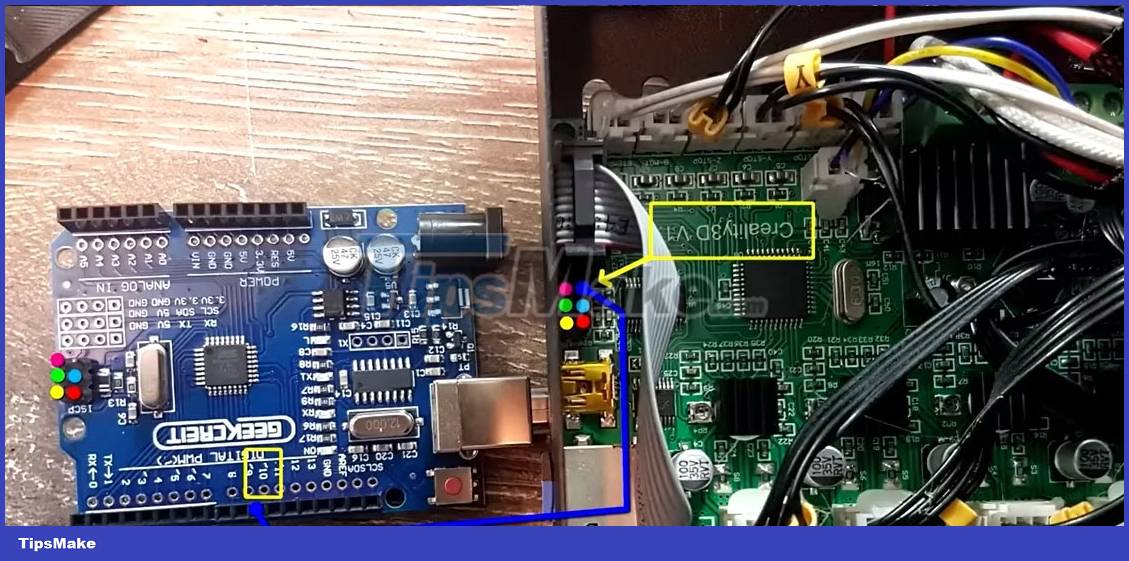How to update 3D printer firmware
3D printer firmware is system software that controls the movement and operation of motors, heaters, and other components. We can call the firmware the brain of the machine and is usually stored on the printer's microcontroller, a small computer programmed to receive commands from the user. Multiple 3D printer firmware options are available, such as Marlin, RepRap, and Klipper.
Follow the steps below to learn how to update the printer firmware easily.
Step 1: Download the firmware
Go to the Marlin website and click the Download Marlin button .

A new window will open, showing the different firmware versions. Select the latest version (at the top), version 2.1.2.1 at the time of writing; click the zip file for it, under Download . Once downloaded, extract the files and proceed to the next step.
Step 2: Get configuration for 3D printer
You can get your 3D printer-specific settings on the Marlin GitHub page, a repository where all the development is happening and you can choose your specific 3D printer. Once you're there, scroll down to Configurations and click on it.

Then go to the Code section and click Download Zip in the drop-down menu.

When you finish downloading the configuration archive, extract it to extract the files.
Step 3: Overwrite the configuration of the firmware
In the extracted configuration files, open the configuration folder, then for example; A range of 3D printers will be listed, as shown below.

Select the folder for your specific 3D printer and copy the Configuration.h and Configuration_adv.h files. These two files contain all the necessary configurations for your 3D printer.
In the unzipped files of the Marlin firmware, go to the Marlin folder and open it, then paste the files you just copied there. You will see a prompt, as shown below.

Choose to replace files. Now that your firmware is configured for the 3D printer, it is ready to compile.
Step 4: Compile and upload the configured firmware
We will use the Arduino IDE with the Marlin software to compile the configured firmware. To do this, go to the Arduino software website and download the IDE version specific to your operating system.

Open the downloaded file and install the Arduino IDE application. Next, double-click the Marlin.ino file in the Marlin firmware folder; it will open in the Arduino IDE.

The next step is to select the microcontroller board. This will vary with different 3D printers; you should research which microcontroller your machine runs on and choose the right one. In this case, the example will choose the Arduino Mega. You choose from Tools > Board > Arduino AVR Boards and you'll see various boards listed there.

Step 5: Upload configured firmware
After selecting the board, click on the checkmark icon in the top left part to verify the details and the compilation will begin.

It will take a few seconds to complete the compilation; if there are errors, they will be displayed in the output (at the end of the IDE). You can connect your 3D printer to your computer with the appropriate USB cable and click the Upload button .

If everything is set correctly, you should update the firmware successfully.
Step 6: Install Bootloader (Optional)
When trying to flash and update the firmware, you may get an error during the process. This could be because your 3D printer doesn't have a bootloader, making it more difficult to update the firmware via the USB cable. To install the bootloader, you will need an Arduino board, a hexagonal screwdriver and an extension cable in addition to the firmware. Then follow the steps below.
1. Remove the 3D printer cover
You can use a screwdriver or hexagonal screwdriver to loosen the screws on the printer's electronics cover. After exploring all visible electronics, get a USB cable and connect one end to the laptop and the other end to the Arduino. Next, lift the lid and install the Arduino so that its ISCP header is facing the same direction as on the 3D printer board, as shown below.

2. Setting up the environment
In the Arduino IDE, go to File > Examples > 11.ArduinoISP > ArduinoISP .

A new window will launch. Go to Tools > Board > Sanguino(1284P Boards) . If you don't see that option, go to the Sanguino GitHub page and copy the add-on URL there.

In the Arduino IDE, go to Arduino IDE > Preferences and paste the URL you copied into the Additional boards manager URLs field . Then click OK and you will see the add-on being downloaded and installed.
When done, go back to Tools > Board > Boards Manager . In the search tab, search for Sanguino and you should see it listed there. Click Install and you will see the packages installed in the output window.

3. Connect the wires and install the Bootloader
Connect the 5-wire female-to-female to the Arduino and the 3D printer's board. Make sure the positions match the ISCP header. Then take a male-to-female wire and connect it to pin 10 of the Arduino and the top right port of the printer board, as shown below.

Now, in the Arduino IDE, go to Tools > Programmer and select Arduino as ISP .

Finally, to successfully install the bootloader, go to Tools > Burn Bootloader .

After a few seconds, you will see a message in the output stating that the process is complete. Remove the Arduino and its connected wires, plug in the USB cable and start uploading the firmware.
You should read it
- How to Update Printer Drivers on a Mac
- AMD released a firmware update for Specter to fix the vulnerability on the CPU
- The best 3D printers 2019
- Do not rush to update Patch Tuesday for November 2021 because it causes printer errors on Windows 10 again
- Inkjet (inkjet) and laser printers: Which type is right for you?
- How to fix offline errors of printers on Windows 10
- How to add a printer on Windows 11
- The printer has ink smudges - Causes and ways to fix the printer ink smudge error
May be interested
- How to share a printer via LAN
 tipsmake.com will guide you how to share the printer via internal lan so many computers can print the document. the article has 2 steps, 1 is to share the printer with another device and 2 is to connect to the shared printer.
tipsmake.com will guide you how to share the printer via internal lan so many computers can print the document. the article has 2 steps, 1 is to share the printer with another device and 2 is to connect to the shared printer. - The most valuable feature on AirPods Pro is having problems after updating the new Firmware
 in the past few days on many major technology forums, there have been many cases of airpods pro owners complaining about active noise cancellation (anc) - the most valuable feature on the headset - unexpectedly poor performance. go without a known cause.
in the past few days on many major technology forums, there have been many cases of airpods pro owners complaining about active noise cancellation (anc) - the most valuable feature on the headset - unexpectedly poor performance. go without a known cause. - The best 3D printers 2019
 if you are looking for the best 3d printer then you are in the right place. this article will introduce some of the top 3d printing devices for you to choose from.
if you are looking for the best 3d printer then you are in the right place. this article will introduce some of the top 3d printing devices for you to choose from. - Instructions on how to replace printer ink at home in the simplest way
 replacing printer ink is a very simple but extremely important task to ensure the best printed text. discover the fastest way to replace printer ink with hacom here!
replacing printer ink is a very simple but extremely important task to ensure the best printed text. discover the fastest way to replace printer ink with hacom here! - What is firmware? How is Firmware different from Software?
 what is firmware? how is firmware different from software? let's tipsmake.com find out in this article offline!
what is firmware? how is firmware different from software? let's tipsmake.com find out in this article offline! - Causes and solutions for blurry printer problems
 printer blur is a problem that many users often encounter due to different causes of ink and components. let's explore with hacom right here.
printer blur is a problem that many users often encounter due to different causes of ink and components. let's explore with hacom right here. - Apple released a new firmware update for AirPods Pro
 apple has just released the firmware update for the airpods pro wireless headset, from version 2c54 or 2b588 to 2d15.
apple has just released the firmware update for the airpods pro wireless headset, from version 2c54 or 2b588 to 2d15. - Microsoft warns new Windows updates can cause printer errors
 microsoft has officially issued a warning that an optional preview update released last week may cause printer errors.
microsoft has officially issued a warning that an optional preview update released last week may cause printer errors. - Inkjet (inkjet) and laser printers: Which type is right for you?
 printing still plays an important role in many cases and then, choosing the printer that best suits your needs is something we need to talk about.
printing still plays an important role in many cases and then, choosing the printer that best suits your needs is something we need to talk about. - How to Fix the 'Printer Offline' Error After a Windows 10 Update
 windows 10 updates can create issues with the regular performance of the device. one such problem is the 'printer offline' error message while printing, but you can fix it easily. reset the printer before anything else. doing so will help...
windows 10 updates can create issues with the regular performance of the device. one such problem is the 'printer offline' error message while printing, but you can fix it easily. reset the printer before anything else. doing so will help...










 How to completely uninstall WSL on Windows 10/11
How to completely uninstall WSL on Windows 10/11 11 reasons to buy a Kindle e-reader
11 reasons to buy a Kindle e-reader 5 secure password alternatives you should consider
5 secure password alternatives you should consider 6 ways to fix the error can't backup files on Windows PC
6 ways to fix the error can't backup files on Windows PC Mortal Kombat 1 PC configuration will require more than 100GB of free space?
Mortal Kombat 1 PC configuration will require more than 100GB of free space? How to find Instagram registration email
How to find Instagram registration email